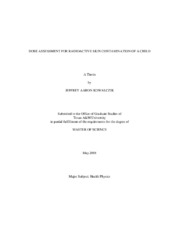| dc.description.abstract | Dose assessments produced using the computer code MCNP are important to
simulate events that are difficult to recreate experimentally. An emergency scenario
involving whole-body skin contamination is one example of such an event. For these
scenarios, an anthropomorphic phantom of a 10-year-old male with uniform skin
contamination was created and combined with MCNP for dose calculations. Activity on
the skin was modeled with gamma-ray sources at energies of 50 keV, 100 keV, 250 keV,
500 keV, 750 keV, 1 MeV, 1.25 MeV, 1.5 MeV, and 2 MeV. The radionuclides 60Co,
137Cs, and 131I were also modeled. The effective dose to the body and major organs was
calculated for each scenario. Exposure rate contour lines were also produced around the
body.
The activity required to result in a dose equal to the legal limit of 0.1 mSv for
minors was calculated for each scenario. The highest activity required to produce this
limit was from the 50 keV gamma-ray source. This activity was increased by an
arbitrary value, approximately tenfold the current value, to represent an emergency
scenario. This new activity concentration of 1 mCi per 100 cm2 was used to produce
doses for each of the scenarios. The lowest effective dose for the body was 0.82 mSv, produced from the 50 keV source. The highest effective dose was 19.59 mSv, produced
from the 2 MeV source. The exposure rates nearest the body were approximately 1.25
R/h, decreasing to100 mR/h approximately 60 cm from the body. The data points were
found to be dependent on the energy of the gamma ray. These data can also be
improved by deriving solutions previously assumed in this scenario. For example, the
skin may be broken down into multiple regions to allow for independent calculations for
regional contamination. The activity on the skin can also be derived from air
concentration models, allowing for the use of other models to be used in conjunction
with this research. | en |


